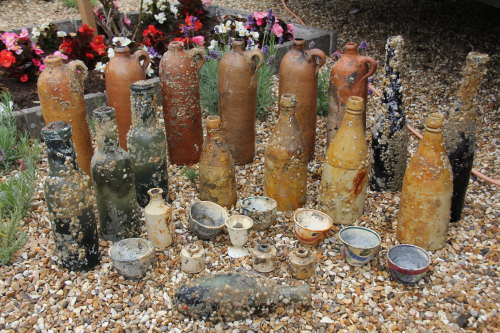
Image use policy
Our images can be used under a CC BY attribution licence (unless stated otherwise).
BOTTLE
Unique ID: MAS-D100071
Object type certainty: Certain
Workflow
status: Published ![]()
Three aqua coloured glass bottles with tooled lips; for foodstuffs or other household goods; probably dating to the 19th century.
These bottles have a double ring also known as a double collar, double bead, double lip, Davis-type, stacked ring, bead lip with a ring, round band lower flared, broad round collar with lower bevel, inverted double ring, citrate of magnesia finish, double roll collar and stacked ring. This two-part finish is composed of two connected 'rings' - usually with a thicker and slightly wider variably rounded ring at the top of the finish with a thinner and narrower variably rounded to flat ring below. Other variations can have either or both rings somewhat or totally flattened on outside, which is similar to the three bottles recorded here.
This popular finish was used on many different bottle types but was most common on a wide array of medicines, many varieties of liquor flasks and various sauces. Between about 1840 and the 1920s, and particularly between 1850 and 1910, this style of finish was one of the most popular and functional finishes used. It can be found on both mouth-blown and machine-made bottles. The lips or double ring on the bottle seem to be a tooled lip which means the lip was formed in the mould itself rather than applied to the bottle separately. The popularity of this finish was probably a combination of corking strength and relative ease of manufacturing (Society for Historical Archaeology webpage, accessed September 2017).
Notes:
These items were found with six stoneware seltzer bottles (MAS-D100065), four stoneware beverage bottles (MAS-D100066), two green glass wine bottles (MAS-D100068), one Hamilton bottle (MAS-D100072), four small stoneware ink bottles (MAS-D100074), six small bowls (MAS-D100076) and one egg cup (MAS-D100078).
All of these items were recovered from the wreck of SS Strathclyde, a British trading steamship built in 1871 in Blackwood, Port Glasgow. The ship sank in 1876 off Dover whilst carrying 23 passengers and 47 crew for Bombay, following a collision with Franconia and resulting in the loss of 38 lives.
NRHE and Kent HER reference numbers cited in this record refer to the wreck of SS Strathclyde.
The location of SS Strathclyde was taken from the British National Grid co-ordinate from the National Record of the Historic Environment.
Class:
Container
Sub class: Food and liquid storage container
Subsequent actions
Current location of find: With finder
Subsequent action after recording: Submitted as wreck to the Receiver of Wreck
Wreck details
Droit number: 173/17
Chronology
Broad period: NINETEENTH CENTURY
Period from: NINETEENTH CENTURY
Period to: NINETEENTH CENTURY
Dimensions and weight
Quantity: 3
Discovery dates
Date(s) of discovery: Monday 24th July 2017
Personal details
Found by: This information is restricted for your login.
Recorded by: L R
Identified by: L M
Secondary identifier: V L
Other reference numbers
NRHE monument number: 813607
Other reference: Kent HER Number: TR 33 NW 23
Droit ID: 173/17
Materials and construction
Primary material: Glass
Manufacture method: Moulded
Completeness: Complete
Spatial coordinates
4 Figure: TR3438
Four figure Latitude: 51.09353995
Four figure longitude: 1.34042371
1:25K map: TR3438
1:10K map: TR33NW
Display four figure position on What3Words
Unmasked grid reference accurate to a 1 metre square.
References cited
No references cited so far.
Similar objects

Find number: MAS-D100074
Object type: INK BOTTLE
Broadperiod: NINETEENTH CENTURY
A collection of four ink bottles; one large and three small.
The larger stoneware ink bottle displays a pourer on the rim and is glazed with …
Workflow: Published![]()

Find number: MAS-D100206
Object type: BOTTLES
Broadperiod: NINETEENTH CENTURY
This find comprises of four stoneware bottles with the inscription "A PHILLIPS VICTORIA VI" and one stoneware ink bottle inscribed "BLACKWOODS…
Workflow: Published![]()

Find number: MAS-D100101
Object type: BOTTLE
Broadperiod: NINETEENTH CENTURY
Two case gin bottles.
Some of the earliest liquor bottles were square in cross section and generally designed to contain gin though undoubted…
Workflow: Published![]()


